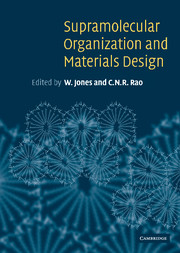Book contents
- Frontmatter
- Contents
- List of contributors
- Preface
- 1 Assembly and mineralization processes in biomineralization: strategies for forming biological composite materials
- 2 Mesoscale materials synthesis and beyond
- 3 Towards the rational design of zeolite frameworks
- 4 Mesoscale self-assembly: the assembly of micron-and millimeter-sized objects using capillary forces
- 5 Design of amphiphiles for the modulation of catalytic, membranous and gelation properties
- 6 Nanofabrication by the surface sol-gel process and molecular imprinting
- 7 The hierarchy of open-framework structures in metal phosphates and oxalates
- 8 Mesoscale self-assembly of metal nanocrystals into ordered arrays and giant clusters
- 9 Layered double hydroxides as templates for the formation of supramolecular structures
- 10 Molecular machines
- 11 Some aspects of supramolecular design of organic materials
- 12 Controlling crystal architecure in molecular solids: the supramolecular approach
- Index
8 - Mesoscale self-assembly of metal nanocrystals into ordered arrays and giant clusters
Published online by Cambridge University Press: 18 December 2009
- Frontmatter
- Contents
- List of contributors
- Preface
- 1 Assembly and mineralization processes in biomineralization: strategies for forming biological composite materials
- 2 Mesoscale materials synthesis and beyond
- 3 Towards the rational design of zeolite frameworks
- 4 Mesoscale self-assembly: the assembly of micron-and millimeter-sized objects using capillary forces
- 5 Design of amphiphiles for the modulation of catalytic, membranous and gelation properties
- 6 Nanofabrication by the surface sol-gel process and molecular imprinting
- 7 The hierarchy of open-framework structures in metal phosphates and oxalates
- 8 Mesoscale self-assembly of metal nanocrystals into ordered arrays and giant clusters
- 9 Layered double hydroxides as templates for the formation of supramolecular structures
- 10 Molecular machines
- 11 Some aspects of supramolecular design of organic materials
- 12 Controlling crystal architecure in molecular solids: the supramolecular approach
- Index
Summary
Nanocrystals of semiconductors as well as of metals covered by alkanethiols organize themselves in two-dimensional arrays. We discuss such arrays of metal nanocrystals at length, with our focus on the dependence of the structure and stability of the arrays on the particle diameter and the distance between the particles. Three-dimensional superstructures of metal nanocrystals obtained by the use of alkanedithiols are examined. These ordered two-and three-dimensional structures of thiolized metal nanocrystals are good examples of mesoscale self-assembly. The association of metal nanocrystals to give rise to giant clusters with magic nuclearity provides an even more graphic demonstration of mesoscale self-assembly.
Introduction
Mesoscale self-assembly of objects of nanometric dimensions is a topic attracting wide attention currently. It is becoming recognized that such self-assembly can occur through a variety of weak forces. Cooperative assemblies of ligated metal [1] and semiconductor nanocrystals [2], as well as of colloidal polymer spheres seem to occur through the mediation of electrostatic and capillary forces [3, 4]. The ability to engineer such assemblies extends the reach of current lithographic techniques and holds promise for a new generation of electronics of the nanoworld. In this context, synthesis and programmed assembly of metal nanocrystals assumes significance [1].
A metal nanocrystal is a tiny chunk of the bulk, measuring a few nanometers with a finite number of metal atoms in it. The forces that govern the nanocrystal structure, however, are different in many ways.
- Type
- Chapter
- Information
- Supramolecular Organization and Materials Design , pp. 265 - 294Publisher: Cambridge University PressPrint publication year: 2001



